2010 News
Experts in disaster
21 December 2010
When disaster strikes, not only are emergency services called upon—academics are suddenly in hot demand. After the Canterbury earthquake struck on 4 September this year, many Victoria-based experts provided on-the-ground advice, as well as research-based insight and analysis.
Science: Analysing the quake
Professor Martha Savage was woken in Wellington when the 7.1 magnitude earthquake hit Canterbury at 4.35am. The geophysicist knew at once that it was a major quake.
“It felt far away, but it felt big. Later that morning after I’d checked the data on the earthquake, I contacted my colleagues Euan Smith and John Townend.”
Martha, Euan and John are experts from Victoria’s School of Geography, Environment and Earth Sciences, who then worked with collaborators at GNS Science to analyse the earthquake.
“We used seismometers—instruments that measure ground motion—to get more data on aftershocks and the previously undiscovered fault line.
“In the week after the earthquake, GNS Science put out a number of instruments, we put out five wider band seismometers and also received a further nine instruments from colleagues in the United States, where I’m from.”
Martha, whose first job was running a seismic network in Nevada, says the seismometers, buried just beneath ground level, were placed right around the Canterbury region.
“They were concentrated in areas which helped us understand the earthquake better. There are permanent seismometers in place around the country but the ones we used helped give us further detail and more localised information.”
Martha says the seismic instruments help scientists to “see” the faults better.
“The main fault that delivered the big quake was triggered by a small initial shock in another fault. The instruments help us gain more detail on faults in the area, what kinds of rocks there are, at what sorts of depths and so on.”
Martha led the Victoria response which involved a number of postgraduate students in the field in Canterbury, as well as working with GNS Science, the University of Wisconsin, Stanford University and the University of Auckland.
One of those students was Kathi Unglert, a Masters student supervised by Martha.
“As well as the broad band seismometers, we placed 200 strong motion sensors. These measure only the bigger earthquakes and fit into the USB port of people’s computers just like a flash drive. We advertised for people to volunteer their homes.”
The responses came flooding in and Kathi worked with the Civil Defence HQ to map where people were from and place sensors where they could gather the best data.
“It was great that so many people were keen to be a part of that research. It helps us calculate the precise location of earthquakes as well as find out how different building materials respond.”
Now, Martha and students like Kathi will analyse this data in the aftermath of the quake for more information on the potential for further earthquakes in the area and to inform building codes in Canterbury.
Student wins Postgraduate Research Excellence Award
1 December 2010
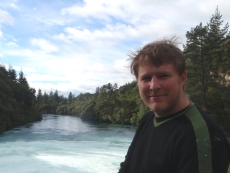
John Creech was recently awarded a Postgraduate Research Excellence Award for work done as part of MSc thesis. The research was presented in a paper entitled ‘Eocene sea temperatures for the mid-latitude southwest Pacific from Mg/Ca ratios in planktonic and benthic foraminifera’, published in Earth and Planetary Science Letters, the third highest ranking journal in this field internationally.
John’s work was a combination of geochemistry and paleoclimate research, and used a laser to sample microscopic marine fossils and measure their chemistry. From these measurements, a temperature record was reconstructed from around New Zealand for the period 51 – 46 million years ago. The record showed sea surface temperatures in the Canterbury Basin varied between 25 - 30˚C, and bottom waters between 15 - 20˚C - temperatures around 20˚C warmer than would be found at the same latitude today.
John has also recently been awarded a Victoria PhD scholarship, and will be studying with Professor Joel Baker and Dr Monica Handler using isotopes of platinum to investigate processes in the early Solar System, including the formation of the Earth.
School hosts visiting lecturer from Leeds
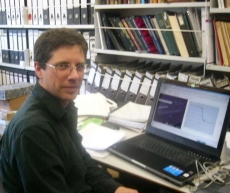
15 November 2010
The School of Geography, Environment and Earth Sciences recently hosted Dr Dan Morgan from the University of Leeds for a two week visit. Dr Morgan is a Lecturer in igneous petrology and volcanology and his research interests include modelling ionic diffusion in igneous crystals.
Dan spent time in the School discussing zoning and diffusion in minerals and volcanology with School staff and PhD and Masters’ students. He also held classes on diffusion modelling that built on the workshops given in his visit in 2009.
“I really enjoyed my time in the School, particularly its wonderful research atmosphere. I was constantly challenged by the questions that students were asking – questions that will help me further my own research. I’d also like to acknowledge the help of Professor Colin Wilson, Professor Terry Seward and Professor Di Seward, who provided valuable input for my current research”, he said.
Marsden Fund grants received by staff across the School
15 October 2010
In the 2010 funding round, full Marsden grants were awarded to Monica Handler and John Overton, with other School staff included in collaborative grants. The results reflect the broad range of research being undertaken in the School.
Dr Monica Handler’s project, Platinum stable isotope tracing of the accretion and differentiation of the Earth and evolution of its oceans and atmosphere, received $830,000.
The project will draw on existing expertise and School facilities to investigate a new stable isotopic system by developing analytical techniques for platinum stable isotope analysis. Two fundamental questions will be tested by applying this tool to a variety of samples including meteorites, igneous rocks and marine sediments: did a late veneer of meteoritic material accrete to the Earth after formation of its core? and, how do platinum isotopes track variations in ocean chemistry and oxygenation of the ocean-atmosphere system through Earth’s history? Prof Joel Baker is also involved with this work.
Professor John Overton gained the first Marsden for the human geography team in the School, with his project titled, The inverse sovereignty effect: The new aid agenda in Pacific Island States, worth $686,631. Prof Warwick Murray is also part of this project.
This project will look at the way aid projects in the Pacific impose considerable burdens on recipient countries, especially those small island states that lack the capacity to deal with the plethora of meetings, reports, accountabilities and monitoring required by donors. Such demands mean that the principle of recipient ''ownership'' of development, a major principle of global aid practice is often undermined.
The research will involve a comparative study of six Pacific Island nations to investigate how size and political status affect the ability of recipient institutions to preserve and promote their own sovereignty over development. The research aims to produce a set of recommendations to inform future practice in the region.
Dr John Townend is a co-principal investigator with Dr Rupert Sutherland of GNS Science and colleagues at five other organisations on the Deep Fault Drilling Project, Alpine Fault which was awarded funding of $920k by the Marsden Council.
The Alpine Fault, New Zealand's most famous and possibly most hazardous fault, is a globally significant target for fault zone studies. It has not produced large earthquakes in historic times, and therefore provides an opportunity to study a major fault late in the cycle of stress accumulation, ahead of a future earthquake.
As part of an ambitious multi-year programme to investigate the fault’s structure, mechanics and evolution, the team will drill down 1.5 km to see beyond the shallow signals caused by landscape, groundwater and climatic processes. Using rock and fluid samples, geophysical and hydraulic data, and by establishing a long-term observatory inside the fault zone, they will gather information as to how large faults operate.
Prof Rewi Newnham is an associate investigator in the grant titled: Bacterial geo-thermometer: A new, precise indicator of climate change.
This research will use microbial membrane lipids preserved in lake sediments as a molecular paleothermometer to increase the precision of New Zealand’s paleoclimate estimates in sites that span the last glaciation. The research follows on from recent progress made with new models for quantitative climate reconstruction using biological indicators, including pollen and insect remains.
The results will allow for better integration of terrestrial and marine climate reconstructions and more robust climate correlation between the northern and southern hemispheres. This project will help to provide a long term context for current climate change, test leading hypotheses about possible causal mechanisms, and constrain models used to predict future climate.
Read more about the Marsden Fund.
Read more about School research in these areas.
Darfield earthquake - 4 September 2010
14 September 2010
The magnitude 7.1 Darfield earthquake is the most damaging earthquake to have struck New Zealand since the 1931 Napier Earthquake and it had the longest surface rupture since the 1929 Buller earthquake.
Although no lives were lost, damage was extensive in the vicinity of the fault and in nearby Christchurch, particularly as a result of liquefaction and the failure of unreinforced masonry. Economic losses are expected to exceed NZ$4 billion.
Understanding the earthquake and its relationship to seismic hazard is profoundly important. The earthquake occurred on a previously unmapped fault in an area that was presumed to pose lower seismic hazard than other areas, particularly the Alpine Fault, the Porters Pass Fault, and other structures in the foothills of the Southern Alps to the northwest.
The analysis of seismic waveforms generated during the earthquake implies a complex sequence of slip indicating that two or more sub-events occurred in quick succession. The fault plane is oriented east-west, whereas most earthquakes in the South Island occur on northeast–southwest-oriented faults.
The Victoria University Geophysics group (Martha Savage, Euan Smith and John Townend) has been busy responding to the earthquake. In addition to radio, TV, magazine and newspaper interviews, they presented a public lecture, available online, and organised teams to go to Christchurch to study the rupture.
Working with GNS Science and colleagues at the University of Auckland, University of Wisconsin, and Stanford University, the GeoNet permanent network has been supplemented by many other seismometers to study the aftershocks. Analysis of data from these units will be undertaken by different groups and will provide valuable information about the fault structure.
Read the GeoNet report of the earthquake.
Ever wondered? Local TV show features Dr John Townend
2 September 2010
Ever Wondered? is a 10-part TV series that takes a celebratory look at the cutting edge scientific research being performed in New Zealand. Each week is dedicated to a particular topic such as earthquakes, astronomy, functional foods and technology in medicine.
Dr John Townend from the School of Geography, Environment and Earth Sciences was featured in this week’s episode discussing 'slow slip' and how earth scientists detect it using global positioning system (GPS) technology.
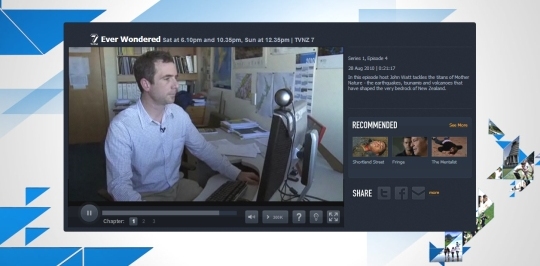
Slow slip is motion on a fault beneath the Earth’s surface that takes place over several days, weeks or months. To date, New Zealand scientists have detected more than a dozen episodes of slow slip using the GeoNet network of instruments operated by GNS Science. The largest of these slow slip events would have been experienced as moderate to large earthquakes if the slip had occurred more rapidly.
"Scientists are now focussing on determining how slow slip in one location might influence large earthquakes nearby. Slow slip locally reduces the pressures acting on a fault, but it might also act as a trigger for earthquakes on nearby faults that remain highly stressed," says John Townend.
Dr John Watt, from the School of Chemical and Physical Sciences is the MacDiarmid Young Scientist of the Year and winner of the Prime Minister’s MacDiarmid Emerging Scientist Prize. John’s role as host is to interview the researchers, showcase the advances and discoveries they’ve made and relate the scientific story to the viewer throughout the series.
Sponsored by the Royal Society of Royal Society of New Zealand, the series is part of TVNZ 7’s Spotlight on Science and Technology Month in August, which is partnered by the Ministry of Research, Science & Technology.
Ever Wondered? began on August 7 and screens on Saturdays at 6.10pm and 10.35pm and Sundays at 12.35pm. Previews and previous episodes are available from the TVNZ 7 website.
Read more about John Townend’s research on the Tectonics and Lithospheric Deformation Research Group webpages.
Podcast - Rapidly Rising Young Rocks
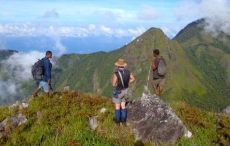
19 August 2010
Our Changing World, Radio New Zealand National.
Papua New Guinea straddles the same plate boundary as New Zealand but the plates move much faster, creating complex tectonic land deformation patterns. In eastern Papua New Guinea, in the Woodlark Basin, the continental crust is rifting apart at rates of 1-2 cm/yr due to the motion of the tectonic plates there. This rifting is causing a new ocean basin to form to the east of the country.
The region is also known as a source of rare rocks called eclogites. These coarse-grained and unusually dense rocks form under high pressure in the Earth’s mantle and then move to the surface. Geologist Tim Little from the School of Geography, Environment and Earth Sciences says eclogites are found in other areas throughout the world, but have emerged tens of millions of years ago and are no longer easily identified. In Papua New Guinea, this process is ongoing and therefore the rocks are much younger, rising to the surface at rates of two to three centimetres a year.
Colleague Laura Wallace, a geophysicist at GNS Science, uses GPS stations to track the horizontal movement of the land and to map out fault lines across the archipelago. Both are part of a larger project at Syracuse University.
Victoria lecturer one of New Zealand’s best
6 August 2010
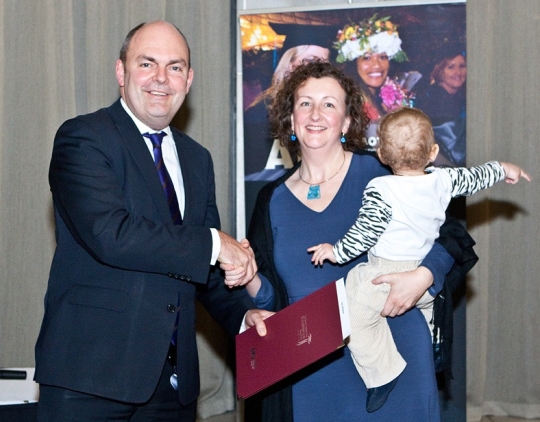
Victoria University Senior Lecturer Sara Kindon is officially one of New Zealand’s top teachers—winning a 2010 AKO Aotearoa Tertiary Teaching Excellence Award at Parliament on Wednesday.
Ms Kindon teaches in Human Geography and Development Studies and uses innovative and research-led approaches to challenge and encourage her students.
At the beginning of one of her postgraduate courses, Young People and Participatory Development, students encounter a high ropes adventure course where they learn to trust their teammates and work with each other off campus. Overcoming fears and building confidence then contributes to collaborative research with young people in Wellington throughout the rest of the course.
“I describe my teaching philosophy as one that is committed to unsettling learners’ assumptions about Geography and Development Studies,” says Ms Kindon.
Evidence suggests this approach brings results. Research carried out through this course has received national recognition from the Human Rights Commissioner for its contribution to positive race relations.
In her other postgraduate course, Geography of Place, Power and Identity, students lead experiential fieldtrips for each other. These engage students in contemporary theories about space and place in different sites in Wellington.
Currently completing her doctoral thesis, she will resume her postgraduate teaching next year, as well as teaching an undergraduate course—Race, Gender and Development—with Dr Jessica Hutchings (Ngai Tahu, Ngati Huirapa).
Ms Kindon has successfully supervised 59 postgraduate students since her appointment in 1994 and has published 12 quality-assured articles and book chapters on aspects of the teaching-research nexus.
A 2008 winner of a Victoria University Award for Sustained Excellence in Teaching, Ms Kindon reserves special mention for Global Remix, a student-led support group she helped to establish for students from refugee backgrounds at Victoria.
“Working with courageous and insightful students, supportive colleagues, and communities in all their diversity are privileges I relish every day.”
Farewell to Richard Willis
2 August 2010
Around 70 current and past staff and students gathered on Friday evening to honour and farewell long-time staff member Dr Richard Willis after nearly 39 years in the School.
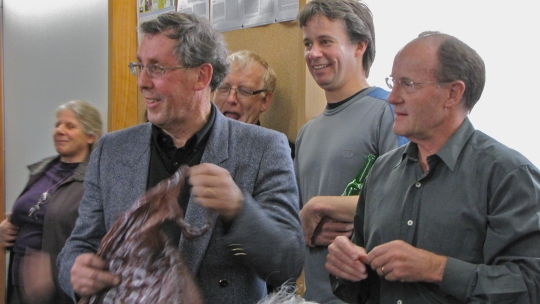
Special guests included Nick Preston, Jim McConchie and members of Richard’s family.
Tributes to Richard highlighted two particular attributes: his extensive knowledge of New Zealand geography and his practical care for other people.
Richard thanked all those present and finished with these words about universities from Robert Engler:
Although Richard has retired, he will continue to teach his popular Geographies of New Zealand course in the summer trimester.
Photo: Geoffrey Hume-Cook
International conference award for school student
20 July 2010
Louise Callard was awarded first prize for the best student presentation at the biennial meeting of the Australasian Quaternary Association (AQUA), in Queensland last week.
The prize was A$3000 to support her attending at next year’s INQUA (The International Union for Quaternary Research) Congress in Switzerland.
Louise’s talk was titled: The last glacial maximum and deglaciation in southern New Zealand: new pollen-climate reconstruction. She is studying for a PhD in Physical Geography with Rewi Newnham.
“I was delighted to receive the award – it was a lovely surprise – and I am looking forward the conference next year.”
New fieldwork fund established
17 June 2010
Geographical Society’s Distinguished Scholar, Ray Watters has created a new fund, the Asia Pacific Research Fund, for the support of postgraduate student field work in the Pacific region and in Asia.
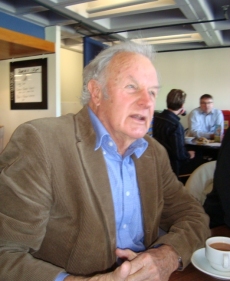
The generous donation will be supplemented with funds from the geography jubilee and invested. Interest from the fund will be distributed to postgraduate applicants on a competitive basis each year.
A lunch was held to celebrate the founding of the award. Colleagues spoke of the outstanding base Ray had laid for research in the Pacific and Latin America during his time at Victoria University. His editorial work in disseminating geography research through the Asia Pacific Viewpoint journal was also mentioned.
Ray Watters retired as Associate Professor of Geography in 1994 but has continued his research and now writing a book about Latin America.
Warwick Murray commented, "we owe Ray Watters a good deal and will pay it back by producing theoretically informed, empirically rich development geographies that have the explicit goal of improving and progressing society for the poor and marginalised. I think the field research award will assist greatly in helping us achieve that."
School celebrates Oxfam’s biggest coffee break
13 May 2010
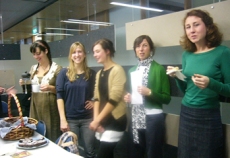
Development studies and human geography Masters students held a ‘Biggest Coffee Break’ in the School with the aim of raising $80 to donate to Oxfam.
Oxfam’s Biggest Coffee Break runs between May 1-16 each year and coincides with Fair Trade Fortnight.
On the menu was Fair Trade coffee and plenty of home baking and those present watched a video about coffee production.
Rewi Newnham was the lucky winner of the ‘Guess the Beans’ competition with an almost exact guess 1500 beans (actual count, 1548). Warwick Murray was the least accurate, with a guess of 5400 beans. Warwick made up for his excessive bean count however by composing and singing an impromptu song about Fairtrade coffee in Latin America.
Those present signed a letter to the new Wishbone café, requesting a change to Fairtrade coffee.
Staff and students made donations to Oxfam and raised over $100.
In 2009 687 Coffee Breaks were held across New Zealand and this year Oxfam estimated that more than 16,000 people took part.
